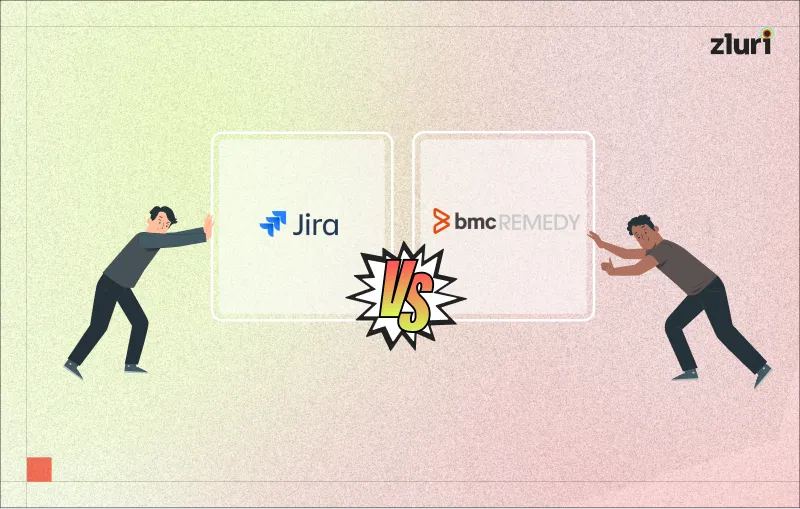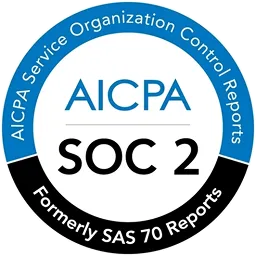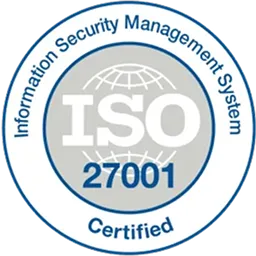Having trouble deciding between JIRA Service Management and BMC Remedy? This in-depth comparison—Jira vs Remedy—will guide you to the right choice. It highlights their strengths, compares market pricing, and more to help you make an informed decision.
Choosing the right IT Service Management (ITSM) tool can significantly impact how efficiently your organization handles IT operations. These tools help organizations manage and deliver IT services efficiently by streamlining service requests, change management, and problem resolution.
When it comes to top contenders, Jira and Remedy are two of the most popular options, each offering powerful features tailored to different business needs.
In this blog, we'll dive into a comparison of Jira and Remedy, helping you determine which tool aligns best with your ITSM requirements. Whether you need a robust ticketing system or advanced incident management, we’ll help you make an informed decision.
Jira Service Management: Core Capabilities

Jira Service Management is a versatile IT service management (ITSM) platform developed by Atlassian. It's designed to help teams manage service requests, incidents, changes, and other IT-related tasks efficiently. Here’s a brief overview:
Key Features
- Request Management: Teams can track and manage requests through customizable queues and workflows. This includes everything from handling support tickets to managing service requests and incident reports.
- Incident Management: The platform helps teams respond to and resolve incidents quickly. It provides tools for tracking incidents, coordinating responses, and analyzing post-incident data to prevent future issues.
- Change Management: Jira Service Management supports managing changes to IT systems with a focus on minimizing risks and disruptions. It offers change request forms, approval workflows, and change tracking.
- Automation & Customizable Workflows: The platform includes robust automation features to streamline repetitive tasks, such as auto-assigning tickets, setting priority levels, and notifying team members of updates. Teams can create and modify workflows to match their processes, ensuring that the tool fits their unique needs.
- Reporting and Analytics: Jira Service Management offers reporting and analytics tools to track performance metrics, identify trends, and make data-driven decisions.
Jira Service Management is widely used by IT teams, but its flexibility and integration capabilities make it suitable for various other service management scenarios as well.
Remedy (BMC Helix): Core Capabilities

BMC Helix (formerly known as BMC Remedy) is a comprehensive IT service management (ITSM) platform developed by BMC Software. It’s designed to enhance IT operations by providing a range of tools and functionalities for managing IT services and infrastructure. Here’s a detailed look at its key aspects:
Key Features
- Incident Management: BMC Helix offers robust solutions for tracking and resolving incidents. It helps IT teams quickly address and resolve issues, minimizing downtime and improving service availability.
- Problem Management: The platform aids in identifying and analyzing the root causes of recurring issues. By implementing problem management practices, teams can reduce the frequency and impact of incidents.
- Change Management: BMC Helix supports comprehensive change management processes, including planning, approval, implementation, and review of changes. This ensures that changes are made with minimal risk and disruption.
- Configuration Management: It includes configuration management database (CMDB) capabilities, allowing teams to track and manage IT assets and their relationships. This helps in understanding the impact of changes and incidents.
- Service Request Management: Users can submit and track service requests through a self-service portal. The platform provides tools to automate request fulfillment and improve efficiency.
- Self-Service Portal: The user-friendly self-service portal allows end-users to submit requests, check the status of their tickets, and access knowledge articles without needing direct assistance from IT staff.
BMC Helix is known for its scalability and ability to handle complex IT environments, making it suitable for large enterprises and organizations with sophisticated IT service management requirements.
Now let’s gets tarted for our comparison Jira vs remedy.
Jira vs Remedy: Head-To-Head Comparison
1: Incident Management Capabilities
When comparing Jira vs Remedy in terms of Incident Management, here's how each platform handles incidents:
Jira Service Management
- Incident Tracking: Jira Service Management provides a streamlined process for logging and tracking incidents. It allows IT teams to create incident tickets, categorize them, and assign them to the appropriate team members.
- Automation: Jira has robust automation capabilities, allowing teams to set up rules that automatically prioritize incidents, assign them to specific agents, and notify stakeholders.
- Integration with DevOps: Jira Service Management integrates well with DevOps tools, enabling teams to quickly link incidents to underlying problems in the development pipeline.
- Collaboration: The platform supports collaborative incident resolution with features like shared queues, internal comments, and linking related tickets, making it easier to work across teams.
Application Scope & Audience: Jira Service Management is often used in fast-paced DevOps environments where incidents need to be resolved quickly. For example, if a server crashes during a product launch, Jira’s automation features can immediately assign the issue to the correct IT team, prioritize it based on its urgency, and send notifications to all relevant stakeholders, reducing downtime.
BMC Remedy (BMC Helix)
- Incident Lifecycle Management: BMC Remedy offers a comprehensive incident lifecycle management system, covering everything from incident creation to resolution and closure. It includes detailed workflows to ensure incidents are managed according to predefined processes.
- Root Cause Analysis: BMC Remedy emphasizes root cause analysis by linking incidents to problems and known errors, helping teams identify and address underlying issues.
- Customization and Automation: The platform provides extensive customization options for incident forms, workflows, and automation rules, allowing organizations to tailor the incident management process to their specific needs.
- Advanced Reporting: BMC Remedy includes advanced reporting tools that provide insights into incident trends, response times, and resolution effectiveness, helping teams improve their overall incident management processes.
Application Scope & Audience: BMC Remedy is favored in industries with complex IT infrastructures, like healthcare or banking. In a hospital setting, when an incident related to a critical piece of software occurs, BMC Remedy’s root cause analysis tools can quickly identify if the issue is linked to a known problem and help prevent future occurrences by addressing the root cause.
Both Jira Service Management and BMC Remedy offer robust incident management features, but the best choice depends on your organization's specific needs—whether you prioritize streamlined automation and DevOps integration or complete lifecycle management and detailed reporting.
2: Change Management Capabilities
When comparing Jira Service Management vs BMC Remedy in terms of Change Management, here's how each platform handles change processes:
Jira Service Management
- Change Request Handling: Jira Service Management provides an intuitive interface for submitting and tracking change requests. Users can create change requests directly within the platform, attaching relevant information, documentation, and approval requirements.
- Workflow Customization: Jira allows teams to customize change management workflows to fit their specific processes. You can define stages such as planning, approval, implementation, and review, ensuring that every change goes through a structured process.
- Automated Approvals: The platform supports automated approval workflows, where change requests are routed to the appropriate approvers based on predefined rules. This helps speed up the approval process while maintaining control over changes.
- Integration with Development Tools: Jira’s strong integration with development tools makes it easy to link changes to related issues in the development pipeline, providing full visibility into the impact of changes on ongoing projects.
Application Scope & Audience: Jira is a great fit for software development teams where frequent updates are made. For instance, when a new feature is released, a change request can be linked to the associated development task, making it easier for teams to track changes and mitigate risks to the broader system.
BMC Remedy (BMC Helix)
- Comprehensive Change Management: BMC Remedy offers a detailed and structured approach to change management. It provides predefined workflows based on ITIL best practices, ensuring that changes are assessed, approved, implemented, and reviewed systematically.
- Risk and Impact Analysis: BMC Remedy places a strong emphasis on assessing the risks and potential impacts of changes. It includes tools for impact analysis, helping teams evaluate the potential consequences of a change before implementation.
- Change Calendar: The platform features a change calendar that helps teams visualize scheduled changes and avoid conflicts. This ensures better coordination and minimizes the risk of disruptions caused by overlapping changes.
- Extensive Reporting: BMC Remedy offers extensive reporting and analytics on change management processes, allowing teams to monitor change effectiveness, compliance with SLAs, and overall impact on service delivery.
Application Scope & Audience: BMC Remedy is more suited for enterprises dealing with high-stakes, infrequent changes, such as an airline implementing a new booking system. Its in-depth risk analysis tools and change calendar help ensure all potential impacts are considered and avoid conflicts, reducing service disruptions.
In short, Jira Service Management is well-suited for organizations that need flexible change workflows, automated approvals, and strong integration with development tools, making it ideal for agile environments. BMC Remedy excels in structured change management, with a focus on risk analysis, impact assessment, and extensive reporting, making it a great choice for organizations that require a more formalized and thorough approach to managing changes.
3: Ticket Management Capabilities
When comparing Jira Service Management and BMC Remedy in terms of ticket management capabilities, here’s how each platform stands out:
Jira Service Management
- User-Friendly Interface: Jira Service Management offers a clean, intuitive interface that makes it easy for users to create, manage, and track tickets. The platform is designed with simplicity in mind, allowing both IT teams and non-technical users to navigate the system with ease.
- Customizable Workflows: Jira allows teams to customize ticket workflows to align with their processes. You can define the stages a ticket goes through, such as "Open," "In Progress," "Resolved," and "Closed," tailoring the flow to match your organization’s needs.
- Automation: Jira excels in automating repetitive tasks within ticket management. Teams can set up rules for automatic ticket assignment, prioritization, and notifications, reducing manual workload and speeding up resolution times.
- Integration with Other Tools: Jira’s integration with other Atlassian products and third-party tools enhances ticket management by allowing seamless communication and linking of tickets to related tasks, incidents, or changes.
Application Scope & Audience: Jira Service Management shines in fast-moving environments where ticket volumes can vary greatly. For instance, in a tech startup with a small support team, Jira’s user-friendly interface allows non-technical staff to submit support tickets easily. Its automation features can help triage and assign tickets based on urgency or complexity, speeding up resolution times and reducing manual work.
BMC Remedy (BMC Helix)
- Comprehensive Ticket Management: BMC Remedy provides a robust and comprehensive ticket management system that supports complex workflows and detailed ticket tracking. It’s built to handle high volumes of tickets while ensuring each one is processed efficiently.
- Advanced Routing and Escalation: BMC Remedy includes advanced routing and escalation features, ensuring tickets are assigned to the right team members and escalated when necessary. This helps maintain service level agreements (SLAs) and improves response times.
- Service Level Management: The platform has strong service level management capabilities, allowing teams to define, monitor, and report on SLAs. This ensures that tickets are resolved within the agreed-upon timeframes, and any breaches are highlighted for corrective action.
- Detailed Reporting and Analytics: BMC Remedy provides extensive reporting and analytics tools that offer insights into ticket management performance, including resolution times, ticket volumes, and agent productivity.
Application Scope & Audience: BMC Remedy, on the other hand, is better suited for large organizations with complex support needs. For example, in a global insurance company dealing with high volumes of customer service requests, BMC Remedy’s advanced routing ensures tickets are directed to the right teams based on service level agreements (SLAs). Escalation rules help keep critical issues from being overlooked, ensuring compliance with SLAs and boosting response efficiency.
In conclusion, Jira Service Management is best for teams seeking a flexible, user-friendly ticket management solution with strong automation and integration features, particularly in agile and collaborative settings. On the other hand, BMC Remedy provides a more comprehensive and structured ticket management approach, with advanced routing, escalation, and SLA management capabilities, making it ideal for organizations that need detailed control and in-depth reporting.
4: Customization & Flexibility
When comparing Jira Service Management vs BMC Remedy in terms of Customization and Flexibility, here’s how each platform caters to specific business needs:
Jira Service Management
- Levels of Customization: Jira Service Management offers a high degree of customization, allowing teams to tailor workflows, fields, and issue types to match their specific processes. Users can create custom workflows that reflect their unique business operations, whether for handling incidents, service requests, or changes. Additionally, you can customize issue screens, notifications, and permissions to align with your team's preferences.
- Flexible Integrations: Jira’s flexibility extends to its integration capabilities. It integrates seamlessly with a wide range of third-party tools, as well as other Atlassian products like Confluence, Bitbucket, and Trello. This allows organizations to build a comprehensive ITSM ecosystem that fits their specific needs.
- User-Friendly Customization: Jira’s customization features are designed to be user-friendly, even for those without deep technical expertise. The platform’s interface allows administrators to make changes easily through drag-and-drop functionality and configuration options, enabling quick adjustments to processes as business needs evolve.
Application Scope & Audience: Jira Service Management is ideal for organizations that need flexibility without heavy technical involvement. For instance, a marketing agency can easily set up custom workflows for different types of service requests—such as design approvals, client support, or project management—without requiring a dedicated IT team. Jira’s integrations with tools like Trello and Slack also make it easy to fit into existing workflows, enhancing team collaboration.
BMC Remedy (BMC Helix)
- Levels of Customization: BMC Remedy offers extensive customization options, particularly suited for large enterprises with complex IT environments. Organizations can create highly specific workflows, forms, and dashboards tailored to their particular requirements. Remedy’s architecture allows for deep customization at almost every level, from user interfaces to backend processes, ensuring that the system can be adapted to the most intricate business processes.
- Tailored Solutions: BMC Remedy is known for its ability to be tailored to the unique needs of large organizations. It supports complex multi-step workflows and allows for the creation of custom modules to address specific business functions. This level of customization is ideal for organizations with specialized ITSM needs that go beyond standard practices.
- Advanced Configuration Options: While BMC Remedy offers powerful customization capabilities, it often requires more technical expertise to implement these changes compared to Jira. The platform provides advanced configuration options, but these may require dedicated IT resources to fully leverage its potential.
Application Scope & Audience: BMC Remedy provides deeper customization for larger organizations with intricate needs. For example, a multinational pharmaceutical company might need highly specific workflows to handle regulatory compliance and internal audits. Remedy’s advanced configuration options allow the company to tailor workflows and processes down to minute details, but it might require dedicated IT resources to set up and maintain these configurations.
To sum up, Jira Service Management strikes a balance between flexibility and ease of customization, making it ideal for organizations that need to adapt quickly without heavy technical involvement. On the other hand, BMC Remedy offers a deeper level of customization, catering to large enterprises with complex ITSM needs.
5: Pricing Comparison - Jira Vs Remedy
When comparing Jira vs Remedy in terms of Pricing, here’s an overview of how they stack up:
Jira Service Management
- Pricing Model: Jira Service Management operates on a subscription-based pricing model. The cost is typically determined by the number of users, with tiered pricing that allows for flexibility as your team grows. Atlassian, the company behind Jira, offers different pricing plans (Free, Standard, Premium, and Enterprise), each with varying features and support levels.
- Scalability: For smaller teams or startups, Jira Service Management can be quite cost-effective, especially with its Free plan that accommodates up to 3 agents. As teams grow, the costs increase, but the platform’s extensive features and automation capabilities often justify the expense.
- Transparency: Atlassian is known for its transparent pricing, with clear breakdowns of what each plan includes. This makes it easier for organizations to predict costs and choose a plan that fits their budget and needs.
BMC Remedy (BMC Helix)
- Pricing Model: BMC Remedy typically uses a more complex pricing structure, often tailored to the specific needs of the organization. Pricing can include factors such as the number of users, the deployment model (on-premises vs. cloud), and the range of modules or features required.
- Enterprise-Level Pricing: BMC Remedy is generally more expensive than Jira Service Management, reflecting its position as an enterprise-grade solution. It is often more cost-effective for large organizations that need a highly customizable and comprehensive ITSM solution.
- Custom Contracts: BMC Remedy often requires custom pricing agreements, particularly for larger deployments. This can offer flexibility for large enterprises but may involve more negotiation and complexity in understanding the total cost of ownership.
Cost-Effectiveness Based on Company Size and Needs
- Jira Service Management tends to be more cost-effective for small to medium-sized businesses, especially those that require flexibility and straightforward pricing. It’s particularly suited for organizations with growing teams and those that benefit from its integration capabilities within the Atlassian ecosystem.
- BMC Remedy is better suited for large enterprises with complex ITSM needs that require a highly customizable and scalable solution. While it may involve a higher upfront investment, its advanced features and comprehensive support can offer long-term value for organizations that need detailed control over their IT operations.
In conclusion, Jira Service Management is more cost-effective and transparent, making it a strong choice for smaller teams and businesses with straightforward ITSM needs. On the other hand, BMC Remedy is designed for large enterprises that require a robust, customizable ITSM solution and are prepared to invest in a more complex pricing model for advanced features and scalability.
Jira vs Remedy: Which One Should You Choose?
Now that we've covered the detailed comparison of Jira vs remedy, you may have a general idea. However, to determine if a specific tool meets your organizational needs, let’s examine various examples and scenarios to help you choose the right tool.
- For example, if you’re a growing tech startup with a small IT team that needs a straightforward, intuitive system to manage service requests, incidents, and changes, Jira Service Management is an excellent choice. Its user-friendly interface and seamless integration with tools like Confluence and Bitbucket make it ideal for teams that need to adapt quickly and efficiently.
Further, if you’re running a mid-sized company that needs a cost-effective, scalable ITSM solution, Jira’s tiered pricing plans and flexibility will provide the features you need at an affordable price.
- On the other hand, if you’re a multinational corporation with various departments, each requiring tailored ITSM processes, BMC Remedy’s extensive customization options will allow you to create highly specific workflows and modules to meet your intricate requirements.
If your organization has the resources to invest in a robust ITSM solution and can handle a steeper learning curve, BMC Remedy’s powerful features and scalability will provide significant value for managing extensive IT operations.
In short, Jira is perfect for those looking for flexibility and ease of use, while BMC Remedy is ideal for organizations that need a robust, enterprise-level ITSM solution.
Handling daily tickets for access requests & approvals is a key part of IT service management. However, both Jira Service Management and BMC Remedy lack specific features for this task. This is where Zluri’s self-service model becomes invaluable, offering a streamlined solution for managing access requests and approvals efficiently. Let’s explore more!
Eliminate Ticket Backlogs with Zluri's Self-Service Portal
Managing access requests can become a time-consuming task for IT teams, often leading to delays and overwhelming ticket backlogs. The real challenge is enabling seamless self-service capabilities that lighten the IT team's load while improving overall productivity.
Zluri's access request management solution streamlines this process by efficiently handling high volumes of tickets and ensuring timely access to essential resources. It addresses common pain points like delays in provisioning, long ticket queues, and the risk of deprioritizing important service requests, ultimately boosting IT efficiency and user satisfaction.

With Zluri, organizations can design multi-step approval workflows tailored to their needs, ensuring a structured and efficient access request process. The platform sends notifications through Slack, informing teams of real-time updates and approvals. Additionally, Zluri automates the provisioning of access to specific applications, which not only speeds up the approval process but also helps maintain security and compliance by controlling access levels.
Zluri's integration with Slack lets teams manage access requests and receive notifications within their preferred communication channels, boosting workflow efficiency and collaboration.
Key Features
- Employee App Catalog: Zluri's intuitive Employee App Catalog makes app requisition easy, similar to popular consumer app stores. According to KuppingerCole's analysis, this feature enables employees to quickly search for and request necessary applications, enhancing productivity and role effectiveness.

Zluri's audit-proof logs enable you to closely monitor incoming requests and issued approvals, helping you detect any lapses and maintain strict adherence to the principle of least privilege.
Further, employees gain access to a comprehensive catalog of over 225,000 applications, supported by a robust built-in database for streamlined requests.
- Streamlined and Customizable Approval Process: Zluri streamlines the approval process by eliminating ticket-based systems, allowing approvers to make quick decisions and avoid SLA breaches. It also offers customizable approval policies to meet organizational needs and compliance standards, ensuring smooth workflow alignment for various access requests.

- Seamless Slack Integration: Zluri integrates smoothly with Slack, automatically sending notifications to approvers about pending requests. This integration helps streamline communication, ensuring that requests are reviewed promptly and efficiently. By bringing notifications into a platform teams already use, Zluri enhances productivity and speeds up response times.

- Override Stalled Requests: Zluri empowers IT admins with the ability to override stalled requests, ensuring that access provisioning is not hindered by bottlenecks or unforeseen delays. Admins can swiftly address and resolve stalled requests, preventing disruptions in access and maintaining operational continuity.
Ready to learn more? Schedule a personalized demo!
Frequently Asked questions (FAQs)
1. Can Jira Service Management work alongside BMC? How?
Yes, Jira vs Remedy can work alongside. This can be achieved through integrations, which allow data to be synchronized between the two platforms. For example, incident tickets created in BMC Remedy can be automatically mirrored in Jira Service Management, enabling teams to collaborate across systems. Integrations can be set up using APIs, middleware tools like Zapier or Workato, or custom-built connectors, ensuring that both systems can operate in harmony while sharing essential data.
2. Do I need to buy marketplace apps to use Jira Service Management?
No, you don’t need to buy marketplace apps to use Jira Service Management. The platform comes with a wide range of built-in features that are sufficient for many organizations' IT service management needs. However, if your organization requires additional functionality or specific integrations, you can enhance Jira Service Management by purchasing apps from the Atlassian Marketplace. These apps can extend the platform’s capabilities, but they are optional based on your specific requirements.






.svg)














